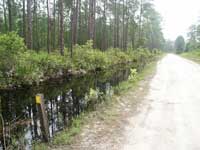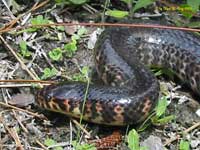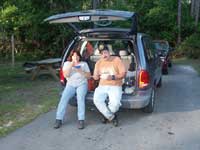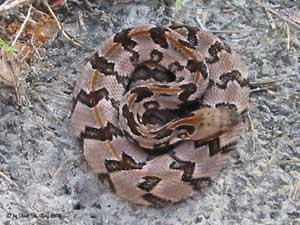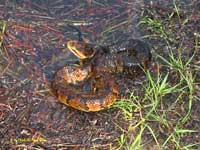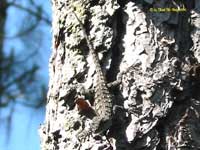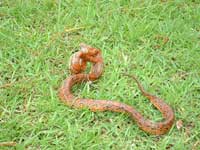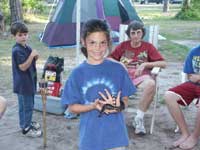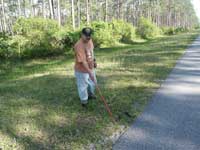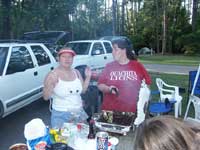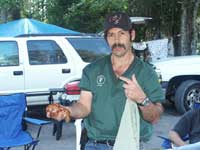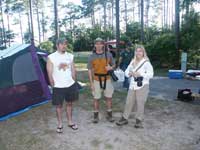Osceola National Forest
|
Editor's Note: This article was accompanied by a few photos. I added some more and just placed them on the side, instead of in the order they were sent to me. This outing was a GREAT time for all who attended. Thank you for all who went and we hope to see the rest of you when we do it again. Article by Karl Betz. The Boss and I were participated in the recent
field trip to the Osceola National Forest to go herping with the
understanding that whatever we found could be held for a group gathering
and photographed as long as it was released where we found it. Nothing
was to leave the forest. What an amazing opportunity! At lunchtime
we all were stopped beside the road eating sandwiches and making
plans when F & G drove up. Two officers were in the vehicle
and they chatted with us for a while. One of the officers said he
knew of me by reputation! He made it sound positive and was very
pleasant to both The Boss and I. WOW! What a difference their pleasant
demeanor made in our trip! They were engaging and friendly and gave
balloons and a whistle and even a Smokey The Bear pencil topper
to the youngest member of our group who is about 6. I was impressed
at the way they interacted with us. It made the trip for me. Quite a few herps were found by the group
and to the best of my knowledge, everything was returned to where
it was found. This is a medium sized Eastern Mud Snake Farancia abacura abacura that was found at about 2 in the afternoon crossing a paved road. There were six cars in a row as we came up on it on our way to the next area to hunt. It was like a train wreck as the first car (actually a pickemup truck) swerved to miss it and at least twelve people scrambled from assorted vehicles to get to the snake before it disappeared into the swampy underbrush that bordered the road. At 5 in the afternoon, we were all supposed to meet back at the campgrounds to share our experiences and to have a chance to photograph what had been found. On the way back to the campground, we came across this subadult Florida Cottonmouth Agkistrodon piscivorus conanti coiled beside the road. As usual, he did not strike and was barely interested in gaping. He just wanted to be left alone. After an extended picture taking session, we left him where we found him. King of the swamplands, a fine symbol of the American south. Once back at the campground, we found that we were not the only ones to have made a venomous discovery. There were two juvenile Canebrake Rattlesnakes Crotalus horridus that had been found crossing paved roads. One was particularly beautiful with its bright cinnamon stripe and pink background. To me, some Canebrakes are prettier than others with all of them being wonderful animals. They were much smaller than captive born ones I have seen. These appeared to be yearlings with about three rattles each. Lizards were a significant part of our day.
Many other snakes were found and seen. Several
turtles were also found. We came across two large Florida Softshell
Turtles Apalone ferox that were crossing the roads in the
midday heat. We also found an adult Florida Redbelly Turtle Pseudemys
nelsoni in a dry ditch. Unfortunately, my turtle pictures are
not that good. I have only portrayed the animals that I managed
decent photographs of, myself. Our last find of the day was half
an hour after sunset on a paved road. Another fine looking Eastern
Mud Snake which The Boss photographed and released. This find was
punctuated by two DORs. One was a very nice looking three foot long
Canebrake and the other a young Florida Water Snake Nerodia fasciata
pictiventris. I couldn't help but notice that the Canebrakes
of this particular area seemed to have disproportionately small
heads compared to others I have observed. Oh well. We left the forest with our photographs, memories, and a very pleasant herping experience but no animals. I hope that you have enjoyed it too. Editor's Note (part II) Other species that were found and caught and/or photographed included the Corn Snake, Elaphe g. guttata, Dusky Pygmy Rattlesnake, Sistrurus miliarius barbouri, Eastern Diamondback Rattlesnake, Crotalus adamanteus.
|
|
Back to home page Back to Past Meetings
